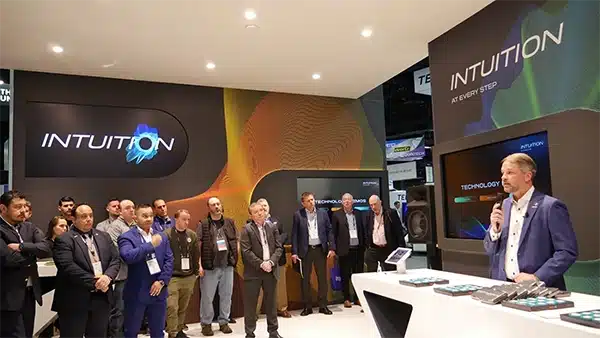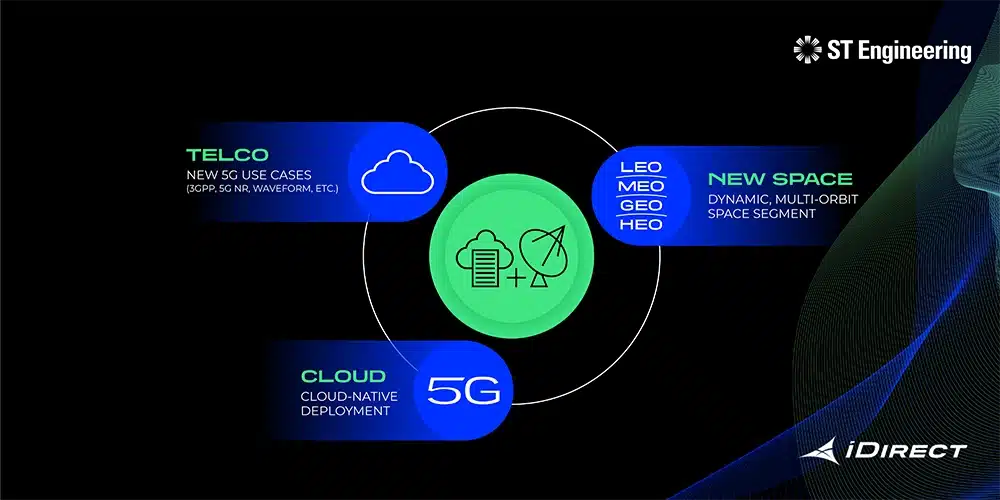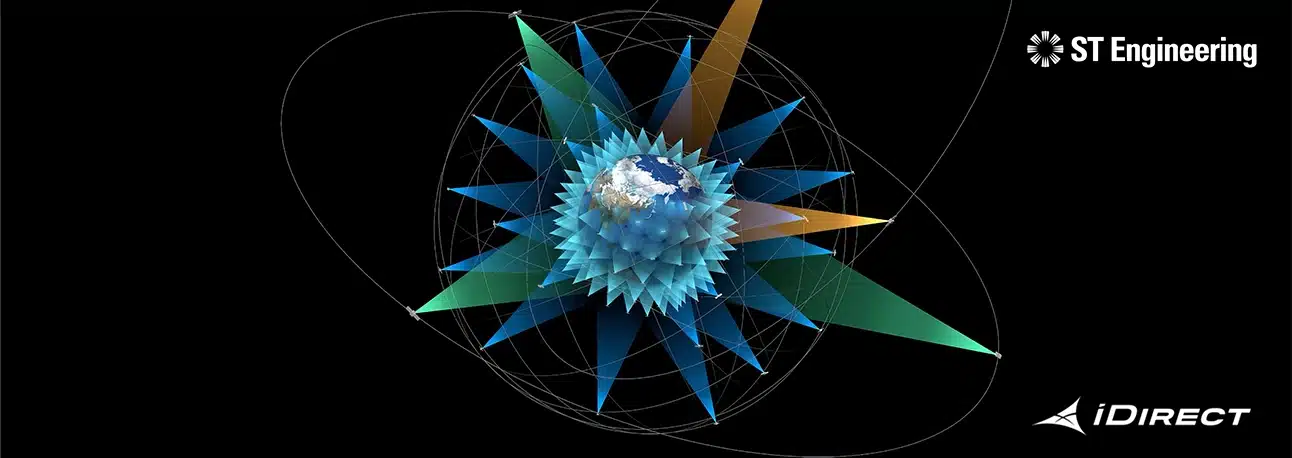At the root of our lives lies connectivity. It’s a necessity that binds our work, travel and leisure time together. Our reliance on connectivity means our lives are built on networks. It’s remarkable to reflect on just how far communications technology has come in past decades – and it shows no signs of stopping. Connectivity continues to evolve, bringing more people, and things, together. Giving instant access to information and each other. However, there’s still a crucial sticking point. Connectivity needs to be ubiquitous – and now, it simply isn’t. We all get frustrated when we can’t get online, or make a call, but when connectivity is critical, breaks in communications just can’t be tolerated.
We know that satellites have the potential to deliver this ubiquity with the emergence of multi-orbit networks in low Earth orbit (LEO), medium Earth orbit (MEO), highly elliptical orbit (HEO) and continued replenishment of geosynchronous orbit (GEO).
We sat down with three members of our leadership team here at ST Engineering iDirect: Don Claussen, our CEO, Sridhar Kuppanna, Senior VP of Engineering and Cynthia Harty, our Senior Vice President of Corporate Development. We asked: How can the satellite industry answer this call for ubiquity and what does it mean for the wider ecosystem, and the people that use it?
Here are the perspectives of our leadership team.
Ubiquity Requires Investment on the Ground
We know that satellite has the potential to deliver connectivity everywhere and with the emergence of multi-orbit networks in low Earth orbit (LEO), medium Earth orbit (MEO), highly elliptical orbit (HEO) and continued replenishment of geosynchronous orbit (GEO) its offering is stronger than ever. Don states: “Space-based communications are required if we’re going to connect everything. It all starts there.”
But satellite networks have gaps of their own that must be addressed if the industry is to provide truly global connectivity. He explains that investment in ground infrastructure is required to bring next-generation ground systems to fruition that offer virtualization and cloudification, multi-orbit support, open standards and industry collaboration.
A New World View for Satellite

Don explained: “If you look across the last 20 years, in particular, fiber was going to solve all our problems. Everybody was going to have fiber in their house. Then the ‘Gs’ came along. First 2G, then 3G, then 4G, and now 5G. 5G is supposed to fix everything. But that’s not going to happen … Everybody has realized that 3G, 4G, and 5G cannot solve all our connectivity issues, and that we’re not going to run fiber to everybody’s home.”
This had led to what Don calls ‘a period of disruption’, which presents an ideal opportunity to increase the addressable market and bring new users in. However, he stresses that first: “we have to define how we’re going to work together to do that.”
So, what does the network need to be able to do? The key word is flexibility.
“The network needs to be able to understand patterns and make adjustments on the fly,” Don explains. “Twenty years ago in the satellite industry, everything was very fixed. Now, everything’s moving around. We’re on airplanes, we’re on ships, and we’re going to be on tractors and in cars. When a plane flies through a beam and then exits it, you might want to move that capacity somewhere else. When the people in a neighborhood wake up and start driving around in their connected cars, you may need to increase satellite capacity there and reduce it somewhere else … Networks need functionality to decide what’s needed and the flexibility to tell a terminal when to switch beams, or a spacecraft when to form them.”
Understanding Operator and Service Provider Needs
The offering from satellite operators today is impressive. They can develop and deploy state-of-the-art software-defined satellites that can create new beams, resize beams and deal with congestion in a dynamic way. This is unprecedented and means that ground system technology providers can work with satellite network operators to maximize their capacity, which is their biggest financial outlay. This also means that the ground segment that supports the satellites must be just as flexible, and this demands tight end–to-end orchestration.
“Our network management system tells the service provider everything they need to know about their iDirect network,” said Cynthia. “We host a wealth of data within the NMS about the ground infrastructure in regard to congestion within beams and compliance with quality-of-service profiles. And as software-defined satellites come online, we need to orchestrate those resources as well so the operator can take full advantage of those satellites’ capabilities. What network operators and service providers want and need is tighter integration to optimize that very expensive component of their delivery value chain.”
Cost isn’t the only challenge for network operators, another is differentiation, a key component of which is the user experience. “The service orchestration from the ground segment to the remote device is all about ‘zero touch.’ Network operators and service providers want the ability to establish new service plans and new offerings; to create them, deploy them, and commission new users without having to increase operational support as their network scales,” Cynthia continued. “That allows them to deliver the best user experience possible while still meeting their financial objectives.”
The challenge lies in how to bring networks in different orbits together so that operations are smooth and seamless for the end user. Engaging the best network for their application, in the most suitable orbit, is extremely complex. The trick will be how to make these transitions effortless.
Unity Going Forward

The Digital Intermediate Frequency Interoperability (DIFI) Consortium, which ST Engineering iDirect helped to pioneer, is focused on developing a digital intermediate frequency/radio frequency (IF/RF) standard to help accelerate the transition from hardware-based systems to software-defined networks.
“Historically, companies in our industry have been vendor-locked. You get terminals and hub infrastructure all from the same vendor, and if you decide to move from one terminal vendor to another, you must replace your entire network,” Sridhar said. “As networks are evolving and recent technology is coming onto satellites, most customers are going to expect a multi-vendor solution … In telco, you can switch from AT&T to Verizon on the fly, and satcom users are going to have the same expectations of satellite networks.”
It’s this ability to move between terrestrial and satellite networks, giving the user ultimate flexibility, that is the holy grail of communications providers. 3GPP is creating a mobile standard that will see terrestrial providers working with satellite operators to achieve connectivity between the two systems.
“It’s critical that 5G releases and eventually 6G releases accommodate satcom natively,” Cynthia said. “When it’s an inherent requirement from the beginning, it will help all of us be able to deliver on true seamless roaming between terrestrial and satcom.”
Change is Unsettling
Change is often difficult to accept, and here we are talking about a fundamental step change, so the industry also needs to understand that it will be dealing with those that are not ready – both inside of and outside of our sector. However, you’ll see ST Engineering iDirect continuing to spearhead standardization efforts and constantly engaging in Proofs of Concept to demonstrate that these innovations work.
Don told us: “When you start talking about something new, there’s always inertia and hesitation, but when you start doing demonstrations—which we’re doing and will continue to do—people begin to realize the benefits. So, we’re absolutely going to drive standards into our products, and we’re going to continue participating in standards bodies to make sure we get to a point where satcom is not an afterthought, but a forethought.”
ST Engineering iDirect has taken responsibility as a leader in the industry, to carry out these Proofs of Concept and educate the industry and their customers.
“All the innovation currently coming to market can be unsettling,” said Cynthia. “Completing these proofs of concept with our partners and customers helps ease anxiety about innovation and proves that it can be done. By doing that work, and doing collaboratively with partners and customers, it makes it easier to adopt new technology.”
Simplifying Complexity
Intuition, our next generation platform is designed to help address all of the above challenges. It sets benchmarks for future ground systems that will help the satcom industry deliver the global connectivity end users demand from it.
The platform is oriented around five capabilities, in particular: virtualization to support fast, cost-effective scaling of services; multi-orbit support to deliver services for a variety of satcom applications, regardless of orbit; standards-based network convergence to integrate satellite networks seamlessly into the global communications domain; end-to-end orchestration to dynamically adjust resource and service allocation in response to variable demand; and flexible go-to-market strategies to reach more customers with the widest possible range of business models.
“We’re building a network of networks. And as we bring these networks together, the complexity lies in operations,” Sridhar said. “Simplifying the operations—how our customers move between networks, including the mobility aspects, the bandwidth management, and delivering service-level agreements for customers regardless of where they are or which network they’re connected to—is critical.”
The creation of self-aware networks that can use emerging technologies such as AI and ML to analyze, predict and orchestrate network traffic for huge networks will play a key role. This will ultimately enable that ubiquity of connectivity that everyone from airline passengers to first responders so desperately craves.
“It wasn’t an accident that we picked the name Intuition for our next-generation product, because it sends a message to industry that intuition is what’s needed,” Don said. “Efficiency is always going to be important, but it’s no longer about who has the most efficient waveform or the smallest modem. It’s about who can bring all these disparate networks together and make it seamless.”
As Don concluded, “it’s not the same old satcom game anymore.”
iDirect Intuition – Fundamentally Change How Satellite Networks Are Deployed
